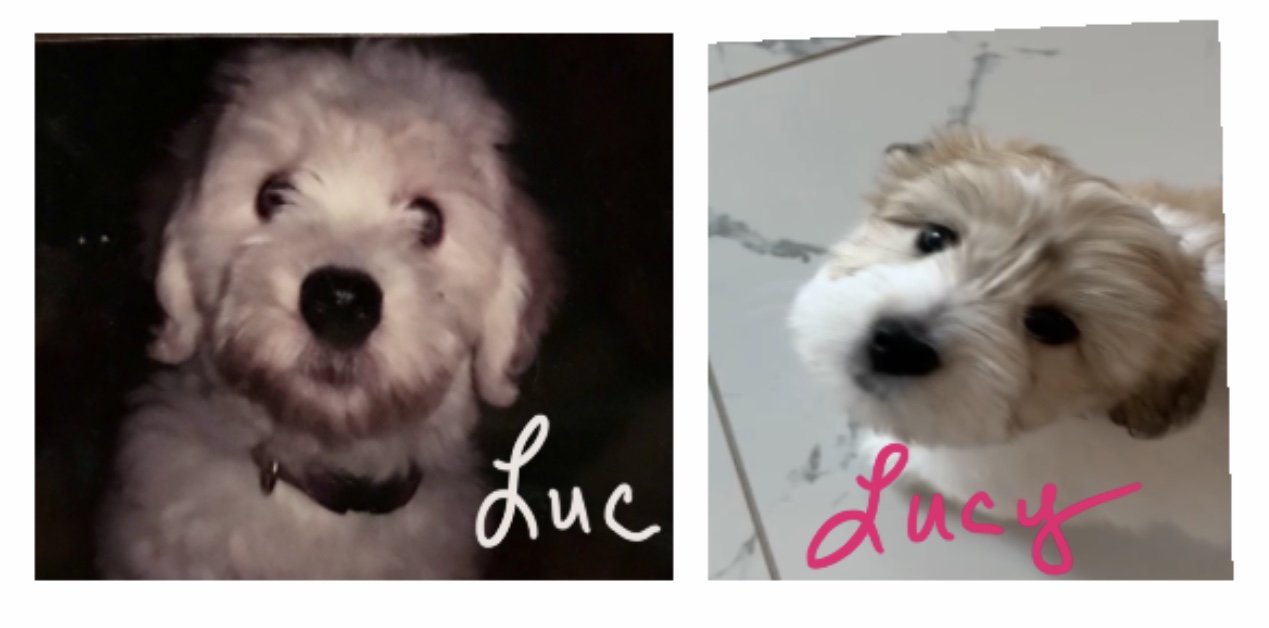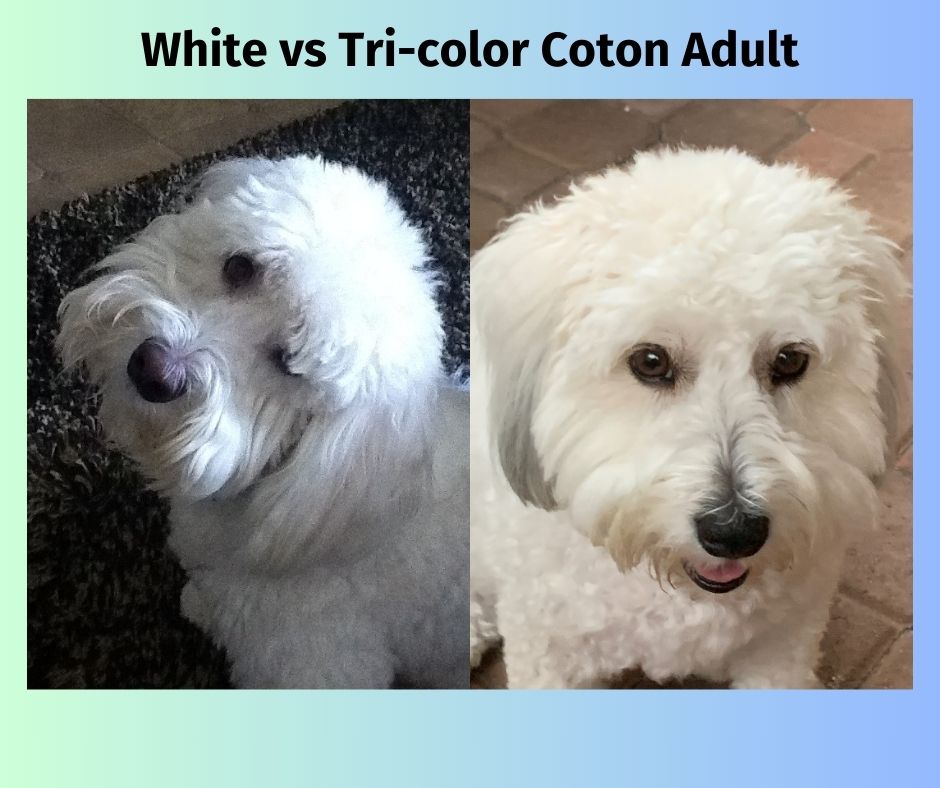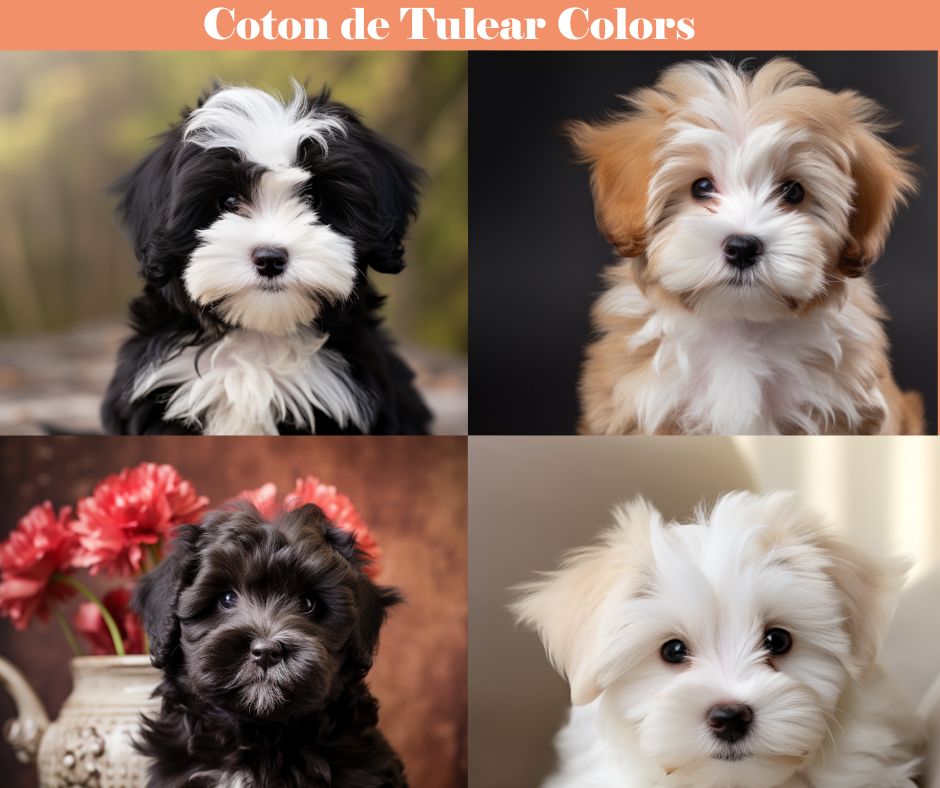Unveiling the Mystery About
Coton de Tulear Color Change
The Coton de Tulear is an adorable and affectionate small breed dog known for its cottony coat. One interesting aspect of this breed is that their coat color can change as they grow older.
Color changes are a natural and common phenomenon in Coton de Tulear dogs, but have you ever looked at your Coton and thought, "Wait a minute, you weren't this color when I brought you home!"?
You're not alone! Let’s dig into why this happens, when to expect it, and what it all means for pet owners.
My dog, Luc, was a 100% white Malagasy Coton de Tulear puppy who remained the same color throughout his entire life. So, it was a very different experience with my second Coton, Lucy, who is a tricolored Malagasy puppy.

Lucy's puppy coat was white with lots of tan color and a little black on her ears. So cute! But now that she’s an adult, she has a primarily white coat with a bit of beige remaining on her ears and back, with just a few black hairs on the bottom of her ears.
I love both versions of Lucy. The only reason I prefer colorful Lucy is because it helped distinguish her from other small white dogs. I wish I had a dollar for every time someone asked if she was a Maltese or Bichon.
As a tricolor, although Lucy’s coat is predominantly white, she doesn’t have that snow white bright white coat that Luc had.
You can see the subtle difference in their adult colors below.

Will your Coton de Tulear puppy change color?
White Cotons will remain white, but you can see from the chart below what to expect from your tan, beige, champagne, lemon, grey, or black Coton.
Coton de Tulear Color Change Chart
|
Puppy Colors Mostly White (51%) |
Adult Colors Will remain mostly white, and any champagne, tan, or beige will likely fade as an adult. |
|
Tricolor (29%) |
White with faded champagne/beige coloring on ears and back. Some black strands may remain on the ears. Even if the color fades, they are always considered tricolored. |
|
Black & White (14%) |
Many black Cotons fade to grey or silver but will never fade to all white. Others will keep their black coloration. Any brown usually disappears completely. |
|
All Black, Brown, or Grey (6%) |
These Colors are less likely to fade. |
Note: The above statistics are from the CTCA website, and have not been adjusted to include the new Coton colors - black, brown, or grey.
One of the common questions I get is whether a non-white Coton is authentically truly a Coton de Tulear. The answer is that while color is a factor in breed standards, it does not determine whether your dog is, in fact, a Coton. Only a DNA test can let you know conclusively if your dog is a Coton. Learn more about DNA tests here.
Let’s look at what the Coton de Tulear breed standard is when it comes to coloring. There are different Coton color standards depending on the breed organization:
The European Coton is white, and anything other than white is considered a fault. The Malagasy Coton’s colors are more faithful to the original breed from the island of Madagascar and consist of genetic diversity with a wider variety of colors, as shown in the table below.
Official Coton de Tulear Colors:
Different Breed Standards
|
AKC American Kennel Club (USACTC) |
95% white. Only 5% of the body is allowed shadings of light tan. This shading is tolerated, not desired. Overall appearance should be white. Any black is disqualified at any age. |
|
FCI Fèdèration Cynologique Internationale (ACC, CCTC) |
All white with only a few shadings of light grey or red-roan (lemon). Shadings are tolerated, not preferred. |
|
UKC United Kennel Club (NACA) |
All white with only a few shadings of light grey or red-roan (lemon). Shadings are tolerated, not preferred and must not exceed 10% of the body. |
|
CKC Canadian Kennel Club |
3 color varieties accepted: -All white, or white with champagne -Tricolor, which is white, brown, and black -Black and white |
|
CTCA / mCTCA Madagascar Coton de Tulear Club of America (MCPC) |
-All white: Allowing champagne highlights on ears and upper back -Tricolor: Mostly white and cream, but tinged with beige areas. Black hairs may dust portions of ears and sometimes body and head. They are usually heavily marked as newborns and juveniles, but may appear mostly white as adults. -Black & white: Pure white with prominent black patches on head and body. In recent years, black puppies, grey puppies, and brown puppies have come in to the gene pool. |
As you can see from this table, different kennel clubs have different standards regarding Coton colors. Only the CTCA recognizes all the Coton colors. It honors the diversity in the breed and accepts all coloring. The CKC also recognizes diversity, but the other breed clubs have little toleration for the different colors of the breed.
These official breed standards are only relevant if you are going to breed or show your dog. But it can be surprising to some Coton parents to bring home a tan and white dog that turns into a primarily white dog after about a year.
It can get confusing, especially since the USA breed clubs fall into different camps when it comes to colors.
The confusion is easy to understand, since different Coton clubs follow different breed standards.
- The United States of America Coton de Tulear Club (USACTC) follows the AKC standard
- The American Coton Club (ACC) follows the FCI standard
- North American Coton Association (NACA) follows the UKC standard
- The Malagasy Coton Club (MCPC) follows the CTCA standard
Now that you know what the Coton standard colors are and which colors change, let's look at why the colors change.
Why Do Coton de Tulear Colors Change?
First, let's get one thing straight: color changes are as natural as your Coton's playful personality. It's not a defect; it's a feature! If you're taking your Coton to the show ring, some colors are considered faults, but in this article, we're focusing on companion dogs, not show dogs. We love all the Coton colors here.
But why do puppy colors change?
Genetic Factors:
Coton de Tulear puppies are typically born with a coat color that may differ from their adult coat color. This is because a dog's coat color is determined by genetics. The genes responsible for coat color can interact and change over time, resulting in a different appearance as the puppy matures.
- Coat Color Genes: Think of your Coton's genes as a painter's palette. Each gene is like a dab of color that contributes to the final picture. Some genes are dominant, like a bold stroke of red, while others are more subtle, like a soft blue hue.
- Inheritance from Parents: Remember, your Coton is a blend of both its mom and dad. It's like mixing two different shades of paint to create a unique new color. So, if you're wondering where that unexpected patch of gray came from, look no further than the family tree!
- Purebred Matters: It's also important to consider whether you have a purebred Coton. Unfortunately, I've heard many stories from visitors who thought they were getting a purebred Coton, only to discover that their dog was a mixture of several breeds. Finding a reputable breeder knowledgeable about this rare breed is so important. Want to know for sure if your dog is a Coton de Tulear? A DNA test is a great way to know for sure.
- Hormonal Changes: Hormonal changes during a Coton’s development can also affect its coat color. These changes, such as puberty or pregnancy, can trigger changes in the production of pigments, leading to color changes in the coat.
- Normal Role of Aging: During the adolescent stage, which usually occurs between the ages of 4 to 12 months, the puppy's coat begins to transition into its adult color. This color change can be subtle or more noticeable, depending on the individual dog. And just like humans go gray, older Cotons may change as they age. It's all part of the circle of life!
I know many people are disappointed when their Cotons grow out of their puppy coloring. But it's not that different from your children who may have blond hair as a baby that later changes to brown hair – it’s a normal part of growing older.
Environmental Factors:
- Sun Exposure: Prolonged exposure to sunlight can lighten or darken your Coton's coat. Just like human hair, the sun’s UV rays can bleach the melanin in the hair shafts, resulting in a lighter appearance. It may be it's time to invest in some doggy sunscreen.
- Diet and Nutrition: You are what you eat, and the same goes for your Coton. Foods rich in certain nutrients can actually enhance coat color. So, if you're into organic, non-toxic living like I am, check out some natural food options that can do wonders for your Coton's coat.
- Health: Sometimes, color changes can indicate underlying health issues. If you notice drastic changes, it's always a good idea to consult your vet.
Misconceptions about
Coton de Tulear Color Change
Let's bust some myths!
- Your puppy’s coat colors will likely change, and you can expect the most dramatic changes between 6 to 12 months. After the first year, the changes are usually more subtle. You can get an idea what your puppy will look like as an adult by checking out its parents.
- Cotons often have a fading gene, which over time can lighten their coloring. This is particularly true for areas like the ears or spots on the back.
- Coat color has nothing to do with a Coton’s purity or quality. It is not true that Cotons de Tulear must be white to be authentic. Genes determine breed; not kennel clubs.
- Even if a tricolored Coton fades to almost all white as an adult, they’re still considered a tricolored Coton.
- Two White Coton parents can produce tricolor or black and white puppies.
So, what does all this mean for your dog? Understanding the factors that influence Coton coat changes, such as genetics and environmental influences, can help you appreciate and embrace the unique beauty of your Coton de Tulear.
But unless you’re going to breed or show your dog, color varieties are just a preference and certainly don’t factor in how much you love your dog.
If you are a proud owner of a Coton de Tulear puppy, marvel at the changes in their coat color as they grow. Embrace their individuality and enjoy the journey as your pup transforms into a stunning adult with a coat uniquely theirs.
Can’t get enough of the Coton de Tulear? Subscribe to our monthly newsletter for more Coton-specific tips, stories, photos, and resources. Just enter your email below.
Home | About Me | Contact Me | Privacy Policy |Disclosure
Copyright© 2008- All Rights Reserved









